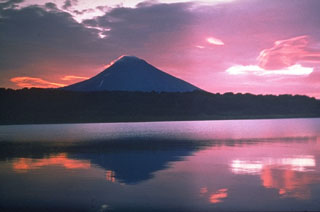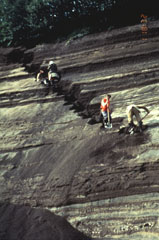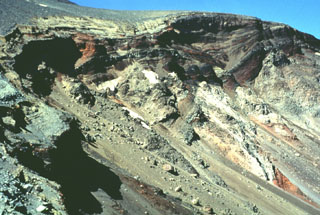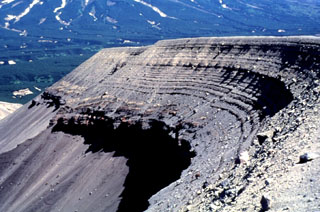

The Global Volcanism Program has no activity reports available for Iliinsky.
The Global Volcanism Program has no Weekly Reports available for Iliinsky.
The Global Volcanism Program has no Bulletin Reports available for Iliinsky.
This compilation of synonyms and subsidiary features may not be comprehensive. Features are organized into four major categories: Cones, Craters, Domes, and Thermal Features. Synonyms of features appear indented below the primary name. In some cases additional feature type, elevation, or location details are provided.
Synonyms |
| Iliinskaya | Iliinskaia, Sopka | Vine | Wine | Ilina | Ozernaia | Ilinsky | Iliyin Sopka | Ilyinsky |
|
|
||||||||||||||||||||||||||
There is data available for 6 confirmed Holocene eruptive periods.
1901 Confirmed Eruption VEI: 3
| Episode 1 | Eruption | NE flank | ||||||||||||||||||||||||||||||||||
|---|---|---|---|---|---|---|---|---|---|---|---|---|---|---|---|---|---|---|---|---|---|---|---|---|---|---|---|---|---|---|---|---|---|---|---|
| 1901 - Unknown | Evidence from Observations: Reported | ||||||||||||||||||||||||||||||||||
|
List of 5 Events for Episode 1 at NE flank
| |||||||||||||||||||||||||||||||||||
0050 (?) Confirmed Eruption
| Episode 1 | Eruption | ||||||||||||||||||||
|---|---|---|---|---|---|---|---|---|---|---|---|---|---|---|---|---|---|---|---|---|
| 0050 (?) - Unknown | Evidence from Isotopic: 14C (uncalibrated) | |||||||||||||||||||
|
List of 2 Events for Episode 1
| ||||||||||||||||||||
2050 BCE (?) Confirmed Eruption
| Episode 1 | Eruption | ||||||||||||||||||||
|---|---|---|---|---|---|---|---|---|---|---|---|---|---|---|---|---|---|---|---|---|
| 2050 BCE (?) - Unknown | Evidence from Isotopic: 14C (uncalibrated) | |||||||||||||||||||
|
List of 2 Events for Episode 1
| ||||||||||||||||||||
2850 BCE (?) Confirmed Eruption VEI: 5
| Episode 1 | Eruption | ZLT tephra | ||||||||||||||||||||||||
|---|---|---|---|---|---|---|---|---|---|---|---|---|---|---|---|---|---|---|---|---|---|---|---|---|---|
| 2850 BCE (?) - Unknown | Evidence from Isotopic: 14C (uncalibrated) | ||||||||||||||||||||||||
|
List of 3 Events for Episode 1 at ZLT tephra
| |||||||||||||||||||||||||
4550 BCE (?) Confirmed Eruption
| Episode 1 | Eruption | |||||||||||||||||||||||||
|---|---|---|---|---|---|---|---|---|---|---|---|---|---|---|---|---|---|---|---|---|---|---|---|---|---|
| 4550 BCE (?) - Unknown | Evidence from Isotopic: 14C (uncalibrated) | ||||||||||||||||||||||||
|
List of 3 Events for Episode 1
| |||||||||||||||||||||||||
5700 BCE ± 50 years Confirmed Eruption VEI: 4
| Episode 1 | Eruption | |||||||||||||||||||||||||
|---|---|---|---|---|---|---|---|---|---|---|---|---|---|---|---|---|---|---|---|---|---|---|---|---|---|
| 5700 BCE ± 50 years - Unknown | Evidence from Correlation: Tephrochronology | ||||||||||||||||||||||||
|
List of 3 Events for Episode 1
| |||||||||||||||||||||||||
There is no Deformation History data available for Iliinsky.
There is no Emissions History data available for Iliinsky.
 Iliinsky volcano at sunrise above the NE shore of Kurile Lake, was constructed beginning about 8,000 years ago within a 4-km-wide caldera of about the same age as the Kurile Lake caldera. It is one of several visible from the shores of one of Kamchatka's most scenic lakes. Its latest eruption, in 1901, created a 1-km-wide crater on the NE flank. The 10-km-wide Kurile Lake caldera was the source of one of Kamchatka's largest Holocene explosive eruptions about 7,600 years ago.
Iliinsky volcano at sunrise above the NE shore of Kurile Lake, was constructed beginning about 8,000 years ago within a 4-km-wide caldera of about the same age as the Kurile Lake caldera. It is one of several visible from the shores of one of Kamchatka's most scenic lakes. Its latest eruption, in 1901, created a 1-km-wide crater on the NE flank. The 10-km-wide Kurile Lake caldera was the source of one of Kamchatka's largest Holocene explosive eruptions about 7,600 years ago. Volcanologists from the Institute of Volcanic Geology and Geochemistry in Petropavlovsk and the New Mexico Institute of Mining and Technology excavate a section through layered tephra deposits from Ilyinsky volcano in southern Kamchatka. Detailed study of the products of individual eruptions are used to determine the timing, frequency, and magnitude of those eruptions. The sequence of tephra layers shown here was deposited by explosive eruptions from Ilyinsky during the last 5,000 years.
Volcanologists from the Institute of Volcanic Geology and Geochemistry in Petropavlovsk and the New Mexico Institute of Mining and Technology excavate a section through layered tephra deposits from Ilyinsky volcano in southern Kamchatka. Detailed study of the products of individual eruptions are used to determine the timing, frequency, and magnitude of those eruptions. The sequence of tephra layers shown here was deposited by explosive eruptions from Ilyinsky during the last 5,000 years. The maar crater in the foreground formed during an eruption in 1901 on the NE flank of Iliinsky volcano. Light-colored tephra was deposited around the rim of the crater and cover the flanks of the volcano. At the end of the eruption lava was extruded on the floor of the 200-m-deep, 1-km-wide crater. Zheltovsky is the volcano to the left of this image.
The maar crater in the foreground formed during an eruption in 1901 on the NE flank of Iliinsky volcano. Light-colored tephra was deposited around the rim of the crater and cover the flanks of the volcano. At the end of the eruption lava was extruded on the floor of the 200-m-deep, 1-km-wide crater. Zheltovsky is the volcano to the left of this image. A 1-km-wide maar was formed in 1901 on the NE flank of Iliinsky. The northern wall of the crater exposes areas of light-colored hydrothermally altered rocks at the base that are surrounded by talus deposits. The darker bedded layers above this are tephra fall deposits of ash and scoria from earlier eruptions of Iliinsky. The light-colored layers (upper left) on the rim of the crater are tephra fall and pyroclastic surge deposits.
A 1-km-wide maar was formed in 1901 on the NE flank of Iliinsky. The northern wall of the crater exposes areas of light-colored hydrothermally altered rocks at the base that are surrounded by talus deposits. The darker bedded layers above this are tephra fall deposits of ash and scoria from earlier eruptions of Iliinsky. The light-colored layers (upper left) on the rim of the crater are tephra fall and pyroclastic surge deposits. The bedded layers in this photo are tephra fall and pyroclastic surge deposits produced by successive explosions during the formation of a maar on the NE flank of Iliinsky in 1901. This eruption created a new crater 800 x 1,000 m wide and 200 m deep that opens to the NE.
The bedded layers in this photo are tephra fall and pyroclastic surge deposits produced by successive explosions during the formation of a maar on the NE flank of Iliinsky in 1901. This eruption created a new crater 800 x 1,000 m wide and 200 m deep that opens to the NE. Zheltovsky rises across a valley NE of Iliinsky volcano. The flat shelf on the right flank is the eastern rim of a 4 x 5 km, largely buried Pleistocene caldera. The western rim of a smaller, late-Holocene caldera forms the break in slope on the left side just below the summit lava dome complex. The crater in the foreground is a NE-flank maar of Iliinsky that formed in 1901.
Zheltovsky rises across a valley NE of Iliinsky volcano. The flat shelf on the right flank is the eastern rim of a 4 x 5 km, largely buried Pleistocene caldera. The western rim of a smaller, late-Holocene caldera forms the break in slope on the left side just below the summit lava dome complex. The crater in the foreground is a NE-flank maar of Iliinsky that formed in 1901. Iliinsky, seen here from the NW, was constructed beginning about 8,000 years ago within a 4-km-wide caldera about the same age as the adjacent Kurile Lake caldera. A period of explosive volcanism during the mid-Holocene lasted 1,000-1,500 years. Growth of the modern cone was completed during the late Holocene. Lava flows cover much of the northern flanks and a 1901 eruption produced a 1-km-wide crater on the NE flank.
Iliinsky, seen here from the NW, was constructed beginning about 8,000 years ago within a 4-km-wide caldera about the same age as the adjacent Kurile Lake caldera. A period of explosive volcanism during the mid-Holocene lasted 1,000-1,500 years. Growth of the modern cone was completed during the late Holocene. Lava flows cover much of the northern flanks and a 1901 eruption produced a 1-km-wide crater on the NE flank. Iliinsky volcano, seen here across Kurile Lake from the SW at the outlet of the Ozernaya River, was constructed during the past 7,600 years above the NE rim of Kurile Lake caldera. The flat ridge with a steep terminus on the left horizon consists of north-flank lava flows that were emplaced about 1,500-2,000 years ago.
Iliinsky volcano, seen here across Kurile Lake from the SW at the outlet of the Ozernaya River, was constructed during the past 7,600 years above the NE rim of Kurile Lake caldera. The flat ridge with a steep terminus on the left horizon consists of north-flank lava flows that were emplaced about 1,500-2,000 years ago.Maps are not currently available due to technical issues.
There are no samples for Iliinsky in the Smithsonian's NMNH Department of Mineral Sciences Rock and Ore collection.
| Copernicus Browser | The Copernicus Browser replaced the Sentinel Hub Playground browser in 2023, to provide access to Earth observation archives from the Copernicus Data Space Ecosystem, the main distribution platform for data from the EU Copernicus missions. |
| MIROVA | Middle InfraRed Observation of Volcanic Activity (MIROVA) is a near real time volcanic hot-spot detection system based on the analysis of MODIS (Moderate Resolution Imaging Spectroradiometer) data. In particular, MIROVA uses the Middle InfraRed Radiation (MIR), measured over target volcanoes, in order to detect, locate and measure the heat radiation sourced from volcanic activity. |
| MODVOLC Thermal Alerts | Using infrared satellite Moderate Resolution Imaging Spectroradiometer (MODIS) data, scientists at the Hawai'i Institute of Geophysics and Planetology, University of Hawai'i, developed an automated system called MODVOLC to map thermal hot-spots in near real time. For each MODIS image, the algorithm automatically scans each 1 km pixel within it to check for high-temperature hot-spots. When one is found the date, time, location, and intensity are recorded. MODIS looks at every square km of the Earth every 48 hours, once during the day and once during the night, and the presence of two MODIS sensors in space allows at least four hot-spot observations every two days. Each day updated global maps are compiled to display the locations of all hot spots detected in the previous 24 hours. There is a drop-down list with volcano names which allow users to 'zoom-in' and examine the distribution of hot-spots at a variety of spatial scales. |
|
WOVOdat
Single Volcano View Temporal Evolution of Unrest Side by Side Volcanoes |
WOVOdat is a database of volcanic unrest; instrumentally and visually recorded changes in seismicity, ground deformation, gas emission, and other parameters from their normal baselines. It is sponsored by the World Organization of Volcano Observatories (WOVO) and presently hosted at the Earth Observatory of Singapore.
GVMID Data on Volcano Monitoring Infrastructure The Global Volcano Monitoring Infrastructure Database GVMID, is aimed at documenting and improving capabilities of volcano monitoring from the ground and space. GVMID should provide a snapshot and baseline view of the techniques and instrumentation that are in place at various volcanoes, which can be use by volcano observatories as reference to setup new monitoring system or improving networks at a specific volcano. These data will allow identification of what monitoring gaps exist, which can be then targeted by remote sensing infrastructure and future instrument deployments. |
| Volcanic Hazard Maps | The IAVCEI Commission on Volcanic Hazards and Risk has a Volcanic Hazard Maps database designed to serve as a resource for hazard mappers (or other interested parties) to explore how common issues in hazard map development have been addressed at different volcanoes, in different countries, for different hazards, and for different intended audiences. In addition to the comprehensive, searchable Volcanic Hazard Maps Database, this website contains information about diversity of volcanic hazard maps, illustrated using examples from the database. This site is for educational purposes related to volcanic hazard maps. Hazard maps found on this website should not be used for emergency purposes. For the most recent, official hazard map for a particular volcano, please seek out the proper institutional authorities on the matter. |
| IRIS seismic stations/networks | Incorporated Research Institutions for Seismology (IRIS) Data Services map showing the location of seismic stations from all available networks (permanent or temporary) within a radius of 0.18° (about 20 km at mid-latitudes) from the given location of Iliinsky. Users can customize a variety of filters and options in the left panel. Note that if there are no stations are known the map will default to show the entire world with a "No data matched request" error notice. |
| UNAVCO GPS/GNSS stations | Geodetic Data Services map from UNAVCO showing the location of GPS/GNSS stations from all available networks (permanent or temporary) within a radius of 20 km from the given location of Iliinsky. Users can customize the data search based on station or network names, location, and time window. Requires Adobe Flash Player. |
| DECADE Data | The DECADE portal, still in the developmental stage, serves as an example of the proposed interoperability between The Smithsonian Institution's Global Volcanism Program, the Mapping Gas Emissions (MaGa) Database, and the EarthChem Geochemical Portal. The Deep Earth Carbon Degassing (DECADE) initiative seeks to use new and established technologies to determine accurate global fluxes of volcanic CO2 to the atmosphere, but installing CO2 monitoring networks on 20 of the world's 150 most actively degassing volcanoes. The group uses related laboratory-based studies (direct gas sampling and analysis, melt inclusions) to provide new data for direct degassing of deep earth carbon to the atmosphere. |
| Large Eruptions of Iliinsky | Information about large Quaternary eruptions (VEI >= 4) is cataloged in the Large Magnitude Explosive Volcanic Eruptions (LaMEVE) database of the Volcano Global Risk Identification and Analysis Project (VOGRIPA). |
| EarthChem | EarthChem develops and maintains databases, software, and services that support the preservation, discovery, access and analysis of geochemical data, and facilitate their integration with the broad array of other available earth science parameters. EarthChem is operated by a joint team of disciplinary scientists, data scientists, data managers and information technology developers who are part of the NSF-funded data facility Integrated Earth Data Applications (IEDA). IEDA is a collaborative effort of EarthChem and the Marine Geoscience Data System (MGDS). |